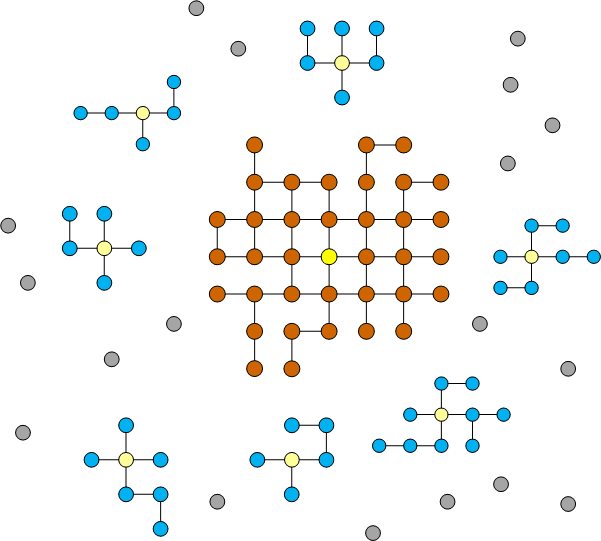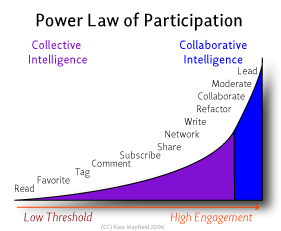"Context, (e)Learning, and Knowledge Discovery for Web User Modeling: Common Research Themes and Challenges" by B.Berendt
This paper is about context and how to define it or how it is defined differently. The following is related to "Context in Web usage mining and eLearning"
2.1 Context as data and as metadata
"In order to evaluate whether intended and actual usage coincide or not, and in order to obtain a more fine-grained picture of actual usage, it is of course interesting to measure aspects of actual usage. "
- This is also one thing that we are interested to find out in MELT, and partly also in my PhD. As we have very little access to "actual use" we try to infer this type of information from usage logs. E.g. We have a teacher who has said in his profile that he teachers students from 12 to 13 year olds. If he bookmarks LOs that have intended audience of 14-18, we can maybe infer that this LO can also be used for younger students. Especially, if we start seeing this taking place a lot, we might want to update the LOM on intended audience: instead of 14-18 we could say 12-18.
- My interest is also to see if tags can give us any hints of this.
2.2 Context and model parts
"context representations can form and/or enrich (a) user models, (b) material/environment models, or (c) interaction models."
- EUN uses a) in one search to rank resources, but we are still only implementing it and we don't know how users react to it. That is related to my own PhD, as are how different search methods are used. In general, we do way too little with user modeling (I guess bigger issues are still more imminent)
2.3 Context: parameters of the (inter)action
- For my PhD I'm looking into user logs to create "levels of user interaction", e.g. what does it mean if a user views a page vs. makes a bookmark on it. We want to use this as an input for a recommendation system, for example.
- I'm also interested in the type of search that the user has chosen and its relation to the search task that the user has at hand.
- Tags were mentioned in this context, that is also a huge part of what I am looking. There are different questions around them, one most interesting related to search is how they can be used for discovering resources.
Need to look into these papers:
- B. Berendt, G. Stumme, and A. Hotho. Usage mining for and on the semantic web. In H. Kargupta, A. Joshi, K. Sivakumar, and Y. Yesha, editors, Data Mining: Next Generation Challenges and Future Directions, pages 461–480. AAAI/MIT Press, 2004.
- Claus-Peter Klas, Hanne Albrechtsen, Norbert Fuhr, Preben Hansen, Sarantos Kapidakis, L aszl o Kov acs, Sascha Kriewel, Andr as Micsik, Christos Papatheodorou, Giannis Tsakonas, and Elin Jacob. A logging scheme for comparative digital library evaluation. In Julio Gonzalo, Costantino Thanos, M. Felisa Verdejo, and Rafael C. Carrasco, editors, ECDL, volume 4172 of Lecture Notes in Computer Science, pages 267–278. Springer, 2006.
- Totally agree with his observation, not the method: Tanimoto [53] emphasizes that may be difficult to conclude, from a mere clicking event, that there was indeed attention paid to (specific) content of the requested page.
2.4 Context: background knowledge
Tags, tags, tags. multiple views.
2.5 Context: Activity structure
" This metadatum can provide important information about a visitor’s intention or expectation (e.g., whether they followed a prescribed link from a course page, or whether they found a material by actively searching with a very detailed search phrase)."
For me this is important, I guess using terms from this paper, I'm interested in user's intentions and expectations and finding out the ways the users choose to access or discover resources in our portal. I'm also interested in seeing whether one method is more useful to a given task, e.g. if people like browsing to find inspirational material and some other method (social information retrieval vs. information retrieval) for another task. If we know what kind of method is useful for a given task, I think we can help our users a lot.
2.6 example
An example is given using the three aspects of context; activity structure, parameters of the (inter)action and background knowledge. The type of analysis allows answering questions like: which search options are popular and are there differences between users? Which content areas were frequented, and how did people navigate between then; did they go back to the search options, or did they use the inter-content links? Did certain content areas become hugs for navigation and thus served to organise the domain and the presentation of the domain? On the other hand, questions like; were there differences between users with high verbal and users with high visuo-spatial competencies; did certain textual or pictoral material become hub?
These are also questions that I am looking at in lre portal and am getting a good idea of them. However, I have not been able to link them with the task at hand yet, which is something that I'm interested in.





